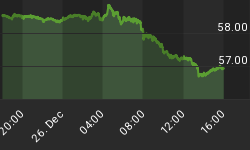For more than a decade investors have been misled. Was the misinformation intentional? Was the misinformation simply due to ineptness? Whatever the cause, the business media, the Street, and many advisors have not served investors well! This author, like many of you, has listened to countless hours of investment gurus talk. We have all read millions of words written in print about how to invest, as advised by experts. How many of them told us ten years ago that future returns in the U.S. equity market would be negative? Go ahead, name two. Not two that you read, but two that were presented by the main stream media.

Our first chart this week, above, portrays the ten-year performance of $Gold and the S&P 500. That black line is the total return, including dividends on the S&P 500. Over the last ten years those that invested in U.S. stocks have lost money. They not only lost the money put into the market, they also lost the dividends received as this is a total return measure. On top of that, some were extracting a fee from the investors for losing them money. We assure you that money can be lost in the market without paying a management fee.
And then we have to hear and read the continuing blather on some bank stock that is up 500% from the low. If one had the misfortune of buying a bank stock on the advice of some investment strategist, that magnificent rise from the low is little comfort. After that 500% rise, the loss on the bank stock is only 91%. That would make me feel better. How about you?
Further, the strategists applauded as hedge fun ran commodity prices up in 2008. Then, we were all told to sell commodities, forever. The Chinese economy was about to disappear, and demand for commodities would never recover. Well, we are still waiting. But, seems the Chinese economy is still in existence. Wealth is still being created in China while in the U.S. wealth may become an endangered species under the wealth confiscation policies of the failing and fading Obama Regime.
As our second chart, below, shows, commodity prices have not exactly followed the expectations of many strategists. Over the more than two and a half years covered by this data, the prices of all of these important Agri-Food commodities have done better than the S&P 500. Even the orphan grain oats, now being served for breakfast at Starbucks, did better.

Eating tends to be a fairly recession resistant habit. Despite the global recession, demand for Agri-Food persisted. Now, the Chinese economy is clearly back to growing. As a consequence, millions more Chinese will join the ranks of the middle class in the years ahead. As that happens, they will consume more Agri-Foods, creating new concerns about the global supply-demand situation in Agri-Food. A new Agri-Food environment is arising, and some will benefit from it.
China and India will, over the next decade, become net importers of Agri-Food to feed their citizens. How will Agri-Food prices react in such an environment? Concern no longer exists, as it did decades ago, on how China would feed itself. They will simply buy the food in world markets. How will the rest of the world afford to eat as China and India bid up the prices paid for Agri-Foods?
Some have already experienced the benefits and joys of the new world of Agri-Foods. However, we do not hear much about these companies. Have any of you heard or read how many day old broilers YUII produced in the latest quarter? Hear anything about HOGS's additions to its pork plants? Or, that CAGE has made a new 52-week recently? No, all we get is drivel on bouncing bank stocks and technology companies of a decade now past.
As our third chart, below, portrays, the Agri-Food stocks, on average, have been doing nicely. Like all groups of stocks, some are up and some are down. Over all, the Agri-Food sector has done better than the market. How many sectors have such a record?

Why has this happened? Agri-Food stocks are tied to the positive economic trends of China. More people have been moved out of poverty in the last decade in China than ever in history. As that has happened, the demand for Agri-Foods has risen. Movement of Chinese citizens into the middle class in the decade ahead will be measured with nine digits. As that prosperity unfolds, the demand for Agri-Foods will rise further.
Then, India will arrive on the scene. Presently, the potential of India's yet to be created economic mass is greater than that of China. The world may be able to feed a prosperous China, but that it can also feed a prosperous India is a real question. It certainly cannot feed both at today's prices!
The beneficiaries of this situation are all those companies that serve the Agri-Food economic sector. Included are fertilizers, seeds, plant protection systems, agrimachinery technology, animal breeders, etc. Technology plays of tomorrow are not some silly social networking sites, they are the technologies to be delivered by the agrimachinery and seed companies. Now that your Gold investments have worked so well, the time has arrived to get serious about tomorrow. Does your portfolio have an offensive component such as Agri-Food? To begin your research use this link: http://home.att.net/~nwschmidt/Order_AgriValueRECENT.html
AGRI-FOOD THOUGHTS is from Ned W. Schmidt,CFA,CEBS, publisher of The Agri-Food Value View, a monthly exploration of the Agri-Food grand cycle being created by China, India, and Eco-energy. To receive this publication, use this link: http://home.att.net/~nwschmidt/Order_AgriValue.html.
















